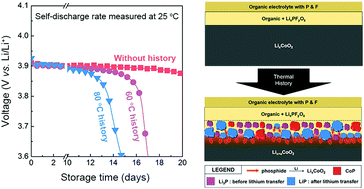当前位置:
X-MOL 学术
›
Energy Environ. Sci.
›
论文详情
Our official English website, www.x-mol.net, welcomes your
feedback! (Note: you will need to create a separate account there.)
Abnormal self-discharge in lithium-ion batteries†
Energy & Environmental Science ( IF 32.4 ) Pub Date : 2018-03-01 00:00:00 , DOI: 10.1039/c8ee00186c Won Mo Seong 1, 2, 3, 4, 5 , Kyu-Young Park 1, 2, 3, 4, 5 , Myeong Hwan Lee 1, 2, 3, 4, 5 , Sehwan Moon 1, 2, 3, 4, 5 , Kyungbae Oh 1, 2, 3, 4, 5 , Hyeokjun Park 1, 2, 3, 4, 5 , Sechan Lee 1, 2, 3, 4, 5 , Kisuk Kang 1, 2, 3, 4, 5
Energy & Environmental Science ( IF 32.4 ) Pub Date : 2018-03-01 00:00:00 , DOI: 10.1039/c8ee00186c Won Mo Seong 1, 2, 3, 4, 5 , Kyu-Young Park 1, 2, 3, 4, 5 , Myeong Hwan Lee 1, 2, 3, 4, 5 , Sehwan Moon 1, 2, 3, 4, 5 , Kyungbae Oh 1, 2, 3, 4, 5 , Hyeokjun Park 1, 2, 3, 4, 5 , Sechan Lee 1, 2, 3, 4, 5 , Kisuk Kang 1, 2, 3, 4, 5
Affiliation

|
Lithium-ion batteries are expected to serve as a key technology for large-scale energy storage systems (ESSs), which will help satisfy recent increasing demands for renewable energy utilization. Besides their promising electrochemical performance, the low self-discharge rate (<5% of the stored capacity over 1 month) of lithium-ion batteries is one of their most significant advantages for ESSs. Herein, contrary to conventional belief, we report that the self-discharge of LIBs can be abnormally accelerated when the battery has been exposed even to a routine short-term thermal exposure. We demonstrate that this thermal ‘history’ in addition to the temperature itself is memorized in the battery and accelerates the self-discharge rate. The series of characterizations performed in our work reveal that the electrolyte salt acts as a strong oxidizing agent by vigorously damaging the surface of the cathode, producing an internal ‘parasitic’ lithium source that continuously supplies lithium for the self-discharge. Although it is widely known that battery operation at elevated temperature generally induces faster degradation of capacity over multiple cycles, the key finding here is that not only the operation temperature but also the ‘thermal history’ of the battery should be carefully considered because this history remains and continues to affect the self-discharge rate afterwards. The self-discharge of LIBs has remained largely neglected; however, our findings suggest that close attention must be paid to the self-discharge of LIBs applied to large-scale ESSs, which, unlike mobile electronic devices, will be exposed to various outdoor temperature conditions.
中文翻译:

锂离子电池的自放电异常†
锂离子电池有望成为大规模储能系统(ESS)的关键技术,这将有助于满足近期对可再生能源利用日益增长的需求。除了具有希望的电化学性能外,锂离子电池的低自放电率(在1个月内小于5%的存储容量)是ESS的最重要优势之一。在此,与传统观点相反,我们报告说,即使将电池暴露于常规的短期热暴露条件下,LIB的自放电也会异常加速。我们证明,除了温度本身之外,这种热“历史”还存储在电池中,并加快了自放电速度。在我们的工作中进行的一系列表征表明,电解质盐通过强烈破坏阴极表面,产生了内部“寄生”锂源,该锂源不断为自放电提供锂,从而使电解质盐成为强氧化剂。尽管众所周知,电池在高温下的运行通常会导致多个循环中容量的快速下降,但此处的关键发现是,不仅应仔细考虑电池的工作温度,而且还应仔细考虑电池的“热历史”,因为这种历史仍然存在并且此后继续影响自放电率。LIB的自放电仍然被很大程度上忽略了;但是,我们的发现表明,必须密切注意应用于大型ESS的LIB的自我排放,
更新日期:2018-03-01
中文翻译:

锂离子电池的自放电异常†
锂离子电池有望成为大规模储能系统(ESS)的关键技术,这将有助于满足近期对可再生能源利用日益增长的需求。除了具有希望的电化学性能外,锂离子电池的低自放电率(在1个月内小于5%的存储容量)是ESS的最重要优势之一。在此,与传统观点相反,我们报告说,即使将电池暴露于常规的短期热暴露条件下,LIB的自放电也会异常加速。我们证明,除了温度本身之外,这种热“历史”还存储在电池中,并加快了自放电速度。在我们的工作中进行的一系列表征表明,电解质盐通过强烈破坏阴极表面,产生了内部“寄生”锂源,该锂源不断为自放电提供锂,从而使电解质盐成为强氧化剂。尽管众所周知,电池在高温下的运行通常会导致多个循环中容量的快速下降,但此处的关键发现是,不仅应仔细考虑电池的工作温度,而且还应仔细考虑电池的“热历史”,因为这种历史仍然存在并且此后继续影响自放电率。LIB的自放电仍然被很大程度上忽略了;但是,我们的发现表明,必须密切注意应用于大型ESS的LIB的自我排放,











































 京公网安备 11010802027423号
京公网安备 11010802027423号